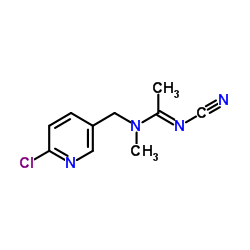Acetamiprid

Acetamiprid structure
|
Common Name | Acetamiprid | ||
|---|---|---|---|---|
| CAS Number | 135410-20-7 | Molecular Weight | 222.674 | |
| Density | 1.2±0.1 g/cm3 | Boiling Point | 352.4±52.0 °C at 760 mmHg | |
| Molecular Formula | C10H11ClN4 | Melting Point | 101-103ºC | |
| MSDS | Chinese USA | Flash Point | 166.9±30.7 °C | |
| Symbol |

GHS06 |
Signal Word | Danger | |
Use of AcetamipridAcetamiprid is a neonicotinoid insecticide used worldwide. Acetamiprid is a nicotinic acetylcholine receptor (nAChR) agonist, and is shown to be associated with neuromuscular and reproductive disorders[1][2]. |
| Name | (E)-acetamiprid |
|---|---|
| Synonym | More Synonyms |
| Description | Acetamiprid is a neonicotinoid insecticide used worldwide. Acetamiprid is a nicotinic acetylcholine receptor (nAChR) agonist, and is shown to be associated with neuromuscular and reproductive disorders[1][2]. |
|---|---|
| Related Catalog | |
| Target |
nAChR[1] |
| In Vivo | Acetamiprid decreases in body weight and mildly affected spermatogenesis. [1]. Acetamiprid decreases the expression of testosterone-metabolism genes, nAChR subunit genes, and proliferation-associated genes in mice[1]. Acetamiprid disrupts subsequent testosterone biosynthesis by decreasing the rate of conversion of cholesterol to testosterone and by preventing cholesterol from entering the mitochondria within the Leydig cells. These effects caused reproductive damage to the rats[2]. Animal Model: Male Sprague Dawley (SD) rats[2] Dosage: 10 mg/kg, 30 mg/kg Administration: Oral gavage; daily; for 35 days Result: Inhibited testosterone synthesis by affecting the mitochondrial function and cytoplasmic adenosine triphosphate production in rat Leydig cells. |
| References |
| Density | 1.2±0.1 g/cm3 |
|---|---|
| Boiling Point | 352.4±52.0 °C at 760 mmHg |
| Melting Point | 101-103ºC |
| Molecular Formula | C10H11ClN4 |
| Molecular Weight | 222.674 |
| Flash Point | 166.9±30.7 °C |
| Exact Mass | 222.067230 |
| PSA | 52.28000 |
| LogP | 0.62 |
| Vapour Pressure | 0.0±0.8 mmHg at 25°C |
| Index of Refraction | 1.571 |
| Storage condition | 0-6°C |
| Symbol |

GHS06 |
|---|---|
| Signal Word | Danger |
| Hazard Statements | H301-H330-H412 |
| Precautionary Statements | P260-P273-P284-P301 + P310-P310 |
| Personal Protective Equipment | Eyeshields;Faceshields;Gloves;type P2 (EN 143) respirator cartridges |
| Hazard Codes | T: Toxic; |
| Risk Phrases | R23/25;R57 |
| Safety Phrases | S45 |
| RIDADR | UN 2811 |
| RTECS | KJ4235200 |
| Packaging Group | III |
| Hazard Class | 6.1(b) |
| HS Code | 2933399022 |
| HS Code | 2933399022 |
|---|---|
| Summary | 2933399022 1,1'-dimethyl-[4,4'-bipyridine]-1,1'-diium。supervision conditions:s(import or export registration certificate for pesticides)。VAT:17.0%。tax rebate rate:9.0%。MFN tarrif:6.5%。general tariff:20.0% |
|
Capillary electrophoresis-mass spectrometry as a new approach to analyze neonicotinoid insecticides.
J. Chromatogr. A. 1359 , 317-24, (2014) This paper represents the first report of a capillary electrophoresis (CE) method compatible with mass spectrometry (MS) detection for simultaneously analyzing seven neonicotinoid insecticides (acetam... |
|
|
Simultaneous determination of neonicotinoid insecticides in human serum and urine using diatomaceous earth-assisted extraction and liquid chromatography-tandem mass spectrometry.
J. Chromatogr. B. Analyt. Technol. Biomed. Life Sci. 969 , 85-94, (2014) A rapid and sensitive analytical method was developed for simultaneous determination of eight neonicotinoid insecticides (acetamiprid, clothianidin, dinotefuran, flonicamid, imidacloprid, nitenpyram, ... |
|
|
Development of a new cucumber reference material for pesticide residue analysis: feasibility study for material processing, homogeneity and stability assessment.
Anal. Bioanal. Chem 407(11) , 3083-91, (2015) The feasibility of the production of a reference material for pesticide residue analysis in a cucumber matrix was investigated. Cucumber was spiked at 0.075 mg/kg with each of the 15 selected pesticid... |
| (1E)-N-[(6-chloro-3-pyridinyl)methyl]-N’-cyano-N-methylethanimidamide |
| (E)-N-[(6-Chloropyridin-3-yl)methyl]-N'-cyano-N-methylacetimidamide |
| (E)-N1-[(6-Chloro-3-pyridyl)methyl]-N2-cyano-N1-methylacetamidine |
| (E)-N-((6-Chloropyridin-3-yl)methyl)-N'-cyano-N-methylacetimidamide |
| acetamiprid |
| (1E)-N-[(6-Chloro-3-pyridinyl)methyl]-N'-cyano-N-methylethanimidamide |
| (E)-N-(6-Chloro-3-pyridylmethyl)-N'-cyano-N-methylacetamidine |
| (E)-N-[(6-Chloro-3-pyridinyl)methyl]-N'-cyano-N-methylethanimidamide |
| Ethanimidamide, N-[(6-chloro-3-pyridinyl)methyl]-N'-cyano-N-methyl-, (1E)- |
| (1E)-N-[(6-chloropyridin-3-yl)methyl]-N’-cyano-N-methylethanimidamide |
| N-[(6-chloropyridin-3-yl)methyl]-N'-cyano-N-methylethanimidamide |
| MFCD06201842 |
| (1E)-N-[(6-Chlorpyridin-3-yl)methyl]-N'-cyan-N-methylethanimidamid |
| T6NJ BG E1N1Y1&UNCN &&E Form |
| (1E)-N-[(6-chloropyridin-3-yl)methyl]-N'-cyano-N-methylethanimidamide |

